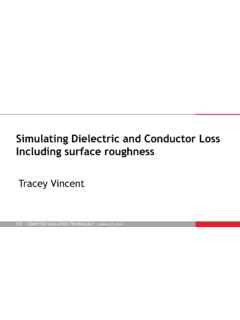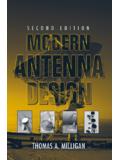Transcription of High-Speed Layout Guidelines - Texas Instruments
1 Application Report SCAA082A November 2006 Revised August 2017. High-Speed Layout Guidelines Alexander Weiler, Alexander Pakosta, and Ankur Verma .. Clock Drivers ABSTRACT. This application report addresses High-Speed signals, such as clock signals and their routing, and gives designers a review of the important coherences. With some simple rules, electromagnetic interference problems can be minimized without using complicated formulas and expensive simulation tools. Section 1. gives a short introduction to theory, while Section 2 focuses on practical PCB design rules. Either section can be read independently. Contents 1 Theoretical Overview .. 1. Electromagnetic Interference and Electromagnetic Compatibility .. 1. Clock Signals .. 2. Transmission Lines .. 3. Crosstalk .. 8. Differential Signals .. 8. Return Current and Loop Areas .. 8. 2 Practical PCB Design Rules .. 9. PCB Considerations During the Circuit Design .. 9. Board 9. Power and Ground Planes.
2 10. Decoupling 13. Traces, Vias, and Other PCB Components .. 14. Clock Distribution .. 17. 3 Summary .. 19. 4 References .. 19. Trademarks All trademarks are the property of their respective owners. 1 Theoretical Overview Some basic understanding is desirable to effectively use the PCB design rules given in this document. It is then easy to identify the undesirable effects that can arise and how to avoid them. The reason PCB Layout becomes more and more important is because of the trend to faster, higher integrated, smaller form factors, and lower power electronic circuits. The higher the switching frequencies are, the more radiation occurs on a PCB. With good Layout , many EMI problems can be minimized to meet the required specifications. Electromagnetic Interference and Electromagnetic Compatibility Electromagnetic interference (EMI) is radio frequency energy that interferes with the operation of an electronic device. This radio frequency energy can be produced by the device itself or by other devices nearby.
3 Electromagnetic compatibility (EMC) is the ability of an electronic product to operate without causing EMI. that would interfere with other equipment and without being affected by EMI from other equipment or the environment. SCAA082A November 2006 Revised August 2017 High-Speed Layout Guidelines 1. Submit Documentation Feedback Copyright 2006 2017, Texas Instruments Incorporated Theoretical Overview The goal is to reduce EMI to meet the requirements given by the Federal Communication Commission (FCC) or the International Special Committee on Radio Interference (CISPR). A basic EMI model is shown in Figure 1. Every device acts as a source and simultaneously as a sink. It can cause interference through a coupling path and can be affected by interference through the coupling path. The coupling can be: Capacitive Inductive Galvanic Radiated power Sink Source Coupling Path Source Sink Figure 1. Model of Electromagnetic Interference There is not just one coupling mechanism present, but rather a combination of them.
4 With proper PCB. Layout , however, these effects can be reduced. Clock Signals Figure 2 illustrates the time and the frequency domain of a clock signal. Ideally, it is a square wave., but in reality, it is not possible to change from low level to high level (and vice versa) in an infinite short time. Due to the rise and fall time, it has the shape of a trapezoid in the time domain. By means of the Fourier series, the trapezoid consists of a series of sine and cosine signals with different frequency and magnitude. The discrete frequency components have an envelope as is shown in the lower diagram of Figure 2. An important aspect is that in the frequency domain the amplitude of the higher frequency harmonics depends on the rise and fall time of the signal. The longer the rise time, the smaller the magnitude of the harmonics. For example, the harmonics of a 100-MHz clock signal are not negligible, especially the third and fifth. In this case, consideration also should be made with frequencies up to 500.
5 MHz. With the CDCE906 from Texas Instruments , the user can set different rise and fall times to reduce the amplitude of the harmonics. However, take care to ensure these times do not violate the slew rate specifications of the driven devices. 2 High-Speed Layout Guidelines SCAA082A November 2006 Revised August 2017. Submit Documentation Feedback Copyright 2006 2017, Texas Instruments Incorporated Theoretical Overview Figure 2. Time Domain and Frequency Domain of a Clock Signal Transmission Lines If the lengths of traces are in the range of the signal's wavelength, then the user has to consider the effects of transmission lines. The problems that a user must deal with are time delay, reflections, and crosstalk. To get a better understanding of these problems and where and how they arise, it is useful to know what transmission lines are. They are simply the traces on a PCB and depend on the length and the frequency of the signals passing through them.
6 Many different structures of trace routing are possible on a PCB. Two common structures are shown in Figure 3. On the left, a microstrip structure is illustrated, and on the right, a stripline technique. A. microstrip has one reference, often a ground plane, and these are separated by a dielectric. A stripline has two references, often multiple ground planes, and are surrounded with the dielectric. Figure 3. Structure and Dimension of microstrip and stripline The following sections describe some important properties of transmission lines which are significant for PCB design. Many software tools are available to calculate the properties of the several transmission line structures. In this application report, the freeware AppCAD from Agilent is used so that the reader can become familiar with these properties. Figure 4 shows the two structures, microstrip (top) and stripline (bottom). The dimensions, the material, and the frequency are in each case shown on the left.
7 The results that are used in the following sections can be seen on the right. Table 1 defines the symbols used in Figure 3 and Figure 4. SCAA082A November 2006 Revised August 2017 High-Speed Layout Guidelines 3. Submit Documentation Feedback Copyright 2006 2017, Texas Instruments Incorporated Theoretical Overview Table 1. Description of the Symbols Used in Figures 3 and 4. SYMBOL DESCRIPTION. H Height of the dielectric W Width of the trace L Length of the trace Frequency The frequency on which the calculations are based Z0 Characteristic impedance of the trace Wavelength Wavelength of the trace at the given frequency and the given effective dielectric 3 10 8 m s l+.. eff . VP Velocity of the signal on this trace with the given dimensions and frequency relative to the speed of light. The absolute velocity is calculated by VP,.absolute = VP,.relative 3 108 m/s eff Combination of the several dielectrics which surrounds the microstrip W/H Ratio between trace width and trace length 4 High-Speed Layout Guidelines SCAA082A November 2006 Revised August 2017.
8 Submit Documentation Feedback Copyright 2006 2017, Texas Instruments Incorporated Theoretical Overview Figure 4. Calculation of Properties of microstrip and stripline (AppCAD). SCAA082A November 2006 Revised August 2017 High-Speed Layout Guidelines 5. Submit Documentation Feedback Copyright 2006 2017, Texas Instruments Incorporated Theoretical Overview Signal speed and Propagation Delay Time A signal cannot pass through a trace with infinite speed . The maximum speed is the speed of light with 3. 108 m/s. For a certain trace length, the signal needs a certain time to pass it, and this is called the propagation delay time. The standard medium for the speed of light is air. For another medium, the dielectric in a PCB environment, the speed is different than that of the speed of light in air. The formula for the speed on a stripline is: 3 108 m s V+. r (1). So, the speed is a function of the dielectric which surrounds the trace. For a microstrip , it is more complicated because the trace is not surrounded by one dielectric.
9 There are at least two: the substrate under the trace and the air above the trace. If the PCB contains a solder mask, a third medium would be present. Therefore, the calculation of an effective r is necessary before determining the signal speed . It depends on the width of the microstrip and the distance to the reference plane. In this case, the speed is a function of the present dielectric, the trace width, and its distance to the reference plane [12]. The signal speed and the propagation delay time, respectively, on a signal trace are important when: Timing and skew requirements must be met (clock distribution, buses, and so forth). Differential traces were used (for example, LVDS). Examples The following parameters are the same in each case: length = 100 mm; thickness = 35 m; height = mm; r = (FR4); frequency = 300 MHz In Table 2, the dependency of signal speed on the trace width at the microstrip structure is shown. Using a stripline , the signal speed is not a function of the trace width.
10 The same is valid for the height. Table 2. Comparison of Propagation Delay Time WIDTH r,eff VP,relative VP,absolute Pd (1). [mm] [mm/ns] [ps/100 mm]. microstrip 1 microstrip 2 1 stripline 1 stripline 2 1 (1). Pd is the propagation delay time in ps on the mentioned line with A 100-mm length. Pd + 1 100 mm mm ns Characteristic Impedance, Reflections, and Termination Another property of a transmission line is the characteristic impedance, Z0. The microstrip in Figure 4 has for the given attributes a characteristic impedance Z0 = 105 , and the stripline Z0 = 55 . If there are any impedance changes in the signal chain (source trace vias connectors sink, and so forth), reflections occur. These reflections cause over- and undershoots. The two extreme are a transmission line with an open end (R = ) and a shorted end (R = 0 ). The reflection coefficient is the dimension which expresses the relationship between the impedance of the transmission line and the impedance of the R * Z0.


















